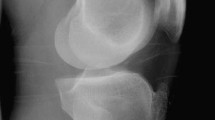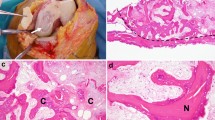Abstract
Sixty New Zealand rabbit models with steroid-induced necrosis of femoral head were exposed to a rotating permanent magnetic field (RPMF) (group A1–2 h/d for one month and group A2–2 h/d for two months), and the changes of femoral head, blood viscosity, serum cholesterol, triglyceride, and pressure within the hip joint cavity were measured and statistically analysed compared to that of control group (B1 and B2) and sham group (C1 and C2). After RPMF treatment, the osteogenesis regeneration of the necrotic femoral head was markedly improved, as was shown by micro-CT. Blood viscosity, serum cholesterol, triglyceride, and pressure in the hip joint cavity were found significantly reduced. RPMF could affect various critical aspects in the course of femoral head necrosis, which will be a promising measure in the prevention and treatment of steroid-induced necrosis of femoral head, especially in the early stage.
Résumé
60 lapins de Nouvelle Zélande présentant une ostéonécrose de la tête fémorale induite par la cortisone ont été exposés à des champs magnétiques rotatoires (groupe A1–2h/d à un mois et groupe A2–2h/d à deux mois). Les modifications de la tête fémorale de la viscosité sanguine du taux de cholestérol et des triglycérides ainsi que les pressions articulaires de la hanche ont été mesurées et analysées statistiquement. Ceci a permis de les comparer à un groupe contrôle (B1 et B2) et à un groupe leurre (C1 et C2). Après traitement par champs magnétiques, la régénération osseuse de la nécrose est améliorée avec une diminution de la viscosité sanguine, du taux de cholestérol et des pressions intra articulaires. Les champs magnétiques peuvent modifier de façon significative l’évolution de la nécrose de la tête fémorale et permettront peut être de prévenir et de traiter les nécroses de la tête fémorale secondaire à un traitement corticoïde surtout à un stade précoce.




Similar content being viewed by others
References
Assouline-Dayan Y, Chang C, Greenspan A, Shoenfeld Y, Gershwin ME (2002) Pathogenesis and natural history of osteonecrosis. Semin Arthritis Rheum 32(2):94–124
Beaule PE, Amstutz HC (2004) Management of Ficat stage III and IV osteonecrosis of the hip. J Am Acad Orthop Surg 12:96–105
Bellot F, Havet E, Gabrion A, Meunier W, Mertl P, de Lestang M (2005) Core decompression of the femoral head for avascular necrosis. Rev Chir Orthop Reparatrice Appar Mot 91:114–123
Chakeres DW, Kangarlu A, Boudoulas H, Young DC (2003) Effect of static magnetic field exposure of up to 8 Tesla on sequential human vital sign measurements. J Magn Reson Imaging 18(3):346–352
Dinulescu I, Stanculescu D, Nicolescu M, Dinu G (1998) Long-term follow-up after intertrochanteric osteotomies for avascular necrosis of the femoral head. Bull Hosp Jt Dis 57:84–87
Eftekhar NS, Schink-Ascani MM, Mitchell SN, Bassett CA (1983) Osteonecrosis of the femoral head treated with pulsed electromagnetic fields (PEMFs). A preliminary report. In: Hungerford, D (ed) The hip. Mosby, St. Louis, MO, pp 306–330
Fisher DE (1978) The role of fat embolism in the etiology of corticosteroid-induced avascular necrosis: clinical and experimental results. Clin Orthop Relat Res 130:68–80
Hirota Y, Hirohata T, Fukuda K, Mori M, Yanagawa H, Ohno Y, Sugioka Y (1993) Association of alcohol intake, cigarette smoking, and occupational status with the risk of idiopathic osteonecrosis of the femoral head. Am J Epidemiol 137:530–538
Hirota Y, Hotokebuchi T, Sugioka Y (1997) Idiopathic osteonecrosis of the femoral head; nationwide epidemiologic studies in Japan. In: Urbaniak JR, Jones JP Jr (eds) Osteonecrosis: etiology, diagnosis, and treatment. American Academy of Orthopaedic Surgeons, Rosemont, IL, pp 51–58
Jones JP Jr (1985) Fat embolism and osteonecrosis. Orthop Clin North Am 16:595–633
Kalla AA, Learmonth ID, Klemp P (1986) Early treatment of avascular necrosis in systemic lupus erythematosus. Ann Rheum Dis 45:649–652
Kim SY, Kim YG, Kim PT, Ihn JC, Cho BC, Koo KH (2005) Vascularized compared with nonvascularized fibular grafts for large osteonecrotic lesions of the femoral head. J Bone Joint Surg Am 87:2012–2018
Kose KC (2004) Femoral head resurfacing for the treatment of osteonecrosis in the young patient. Clin Orthop Relat Res 425:290–291
Kotani H, Kawaguchi H, Shimoaka T, Iwasaka M, Ueno S, Ozawa H, Nakamura K, Hoshi K (2002) Strong static magnetic field stimulates bone formation to a definite orientation in vitro and in vivo. J Bone Miner Res 17(10):1814–1821
Ludwig J, Lauber S, Lauber HJ, Dreisilker U, Raedel R, Hotzinger H (2001) High-energy shock wave treatment of femoral head necrosis in adults. Clin Orthop Relat Res (387):119–126
Mont MA, Hungerford MW (2000) Therapy of osteonecrosis. Basic principles and decision aids. Orthopade 29:457–462
Reis ND, Schwartz O, Militianu D, Ramon Y, Levin D, Norman D, Melamed Y, Shupak A, Goldsher D, Zinman C (2003) Hyperbaric oxygen therapy as a treatment for stage-I avascular necrosis of the femoral head. J Bone Joint Surg Br 85(3):371–375
Seber S, Omeroğlu H, Cetinkanat H, Köse N (2003) The efficacy of pulsed electromagnetic fields used alone in the treatment of femoral head osteonecrosis: a report of two cases. Acta Orthop Traumatol Turc 37(5):410–413
Tang S, Chan TM, Lui SL, Li FK, Lo WK, Lai KN (2000) Risk factors for avascular bone necrosis after renal transplantation. Transplant Proc 32(7):1873–1875
Van Veldhuizen PJ, Neff J, Murphey MD, Bodensteiner D, Skikne BS (1993) Decreased fibrinolytic potential in patients with idiopathic avascular necrosis and transient osteoporosis of the hip. Am J Hematol 44:243–248
Wang GJ, Sweet DE, Reger SI, Thompson RC (1977) Fat-cell changes as a mechanism of avascular necrosis of the femoral head in cortisone-treated rabbits. J Bone Joint Surg Am 59:729–735
Wang TY, Avlonitis EG, Relkin R (1988) Systemic necrotizing vasculitis causing bone necrosis. Am J Med 84:1085–1086
Zizic TM, Marcoux C, Hungerford DS, Dansereau JV, Stevens MB (1985) Corticosteroid therapy associated with ischemic necrosis of bone in systemic lupus erythematosus. Am J Med 79:596–604
Author information
Authors and Affiliations
Corresponding author
Rights and permissions
About this article
Cite this article
Pan, X., Xiao, D., Zhang, X. et al. Study of rotating permanent magnetic field to treat steroid-induced osteonecrosis of femoral head. International Orthopaedics (SICOT) 33, 617–623 (2009). https://doi.org/10.1007/s00264-007-0506-7
Received:
Revised:
Accepted:
Published:
Issue Date:
DOI: https://doi.org/10.1007/s00264-007-0506-7




